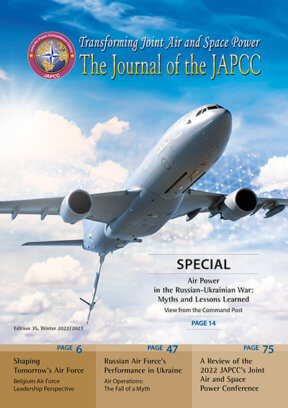Commercial Space Steps in the Spotlight
In today’s connected world, communication and information offered by and through Space capabilities impact people’s everyday lives. Russia’s war of aggression against Ukraine has highlighted what may happen if existing networks are denied. The harsh reality of a ‘day without Space’ was never entirely obvious before. In response to Russia’s invasion, the Western world lost no time authorizing several economic sanctions, including those that degraded the Russian Space programme. Russia, one of the major competitors in the so-called ‘Space Race’ since its inception, responded in the Space domain by threatening to destroy cooperation on the International Space Station (ISS), suspending Soyuz rocket launches, and jamming Global Positioning System (GPS) satellite signals. Space-capable nations and Alliance members have utilized military and governmental systems to mitigate Russia’s actions in the Space domain so far. However, few could have foreseen that, just sixty years after the launch of the first commercial Space mission, Telstar 1, in 1962, a nation’s essential wartime requirements may depend on a tweeted request to a private company for internet services.
In response to Russia’s war of aggression, the commercial Space enterprise stepped in to cover the gap with communications, remote sensing, and launch capabilities. Aided by commercial Space, Ukraine transitioned from terrestrial to Space-based communication in a matter of days, despite expectations that it would take months, even years. This article will provide a brief history of cooperation and interdependence in the Space domain, describe how commercial Space responded to the events in Ukraine, and finally develop some observations and recommendations for both non-NATO nations and Alliance members to incorporate commercial Space. The war in Ukraine has provided essential lessons on how countries outside NATO territory, with limited or no Space capabilities, can leverage commercial Space to overcome the dependency on terrestrial communication systems and disruption of Space data, products, and services (DPS) to succeed on the battlefield.
Cooperation and Interdependence
The first Space collaboration occurred in 1975 when the United States (US) and the Soviet Union shared a ride on the Soviet Soyuz capsule in the first crewed international Space mission. Relations strengthened in 1993 when the US and Russia officially became full partners in the ISS. The joint missions ensured the presence of at least one crew member on board the station from each country at all times.1 Also, the European Space Agency (ESA) and the Russian Federal Space Agency entered long-term cooperation in 2005, with Russia providing Soyuz launch capability from the ESA spaceport in French Guiana.2 This spaceport acts as the primary launch location for ESA, affording multiple orbits.
The US-Russia relationship soured after Russia’s 2014 invasion of Crimea. The US determined that Russia posed a strategic threat and, therefore, directed the Space industry to develop a dedicated Space launch programme, ceased scientific and industrial cooperation with the Russian Space industry, and denied export licenses for high-technology items that could aid Russian military capabilities. On the other front, ESA and most Alliance members maintained the Soyuz launches with Russia, after the invasion of Crimea, without taking any actions to develop alternatives.
Over the last several years, Russia’s overall share in the international Space-launch market diminished due to a combination of factors. These include the rise of private Space-launch competitors lowering the launch costs, the legacy Space industry’s failure to innovate or expand beyond its ageing Space-launch service fleet, and the sanctions imposed following Russia’s 2014 annexation of Crimea. Although Russia remains one of the top three launching countries (averaging 14 to 24 percent of annual orbital launches, between 2017 and 2021, compared to 20 to 32 percent for the US during the same period), most Russian on-orbit assets rely on outdated technology. Moreover, most Russian Space assets launched in the twenty-first century either depended on Western technology or used service modules made in Russia which were outfitted with cutting-edge payloads produced by foreign manufacturers. Post-Crimea sanctions gravely undermined the status quo for the Russian Space industry.
Key Events Related to Ukraine War
Space is essential for Alliance’s deterrence and defence posture; therefore, it is valuable to detail events in the fifth domain related to Ukraine. Even though the war started on 24 February, several earlier hostile actions by Russia, such as anti-satellite tests and jamming attempts over Europe, were already indicators. The following are highlights of the key events observed in the Space domain before and during the invasion of Ukraine, which affected the western world.
- In November 2021, Russia successfully demonstrated its ability to destroy a satellite in Low Earth Orbit (LEO), resulting in over 1,500 pieces of orbital debris. This event represented a warning to western nations and commercial companies which might oppose Russia.
- Since December 2021, Ukraine observed continuous and increasing GPS signal interference.3
- On 4 February 2022, during the Russia-China summit, the parties agreed there would be no forbidden areas of cooperation.4 China had no objections over the war in Ukraine, and Roscosmos, the Russian Space Agency, sought China’s support to mitigate western sanctions with components and partnership in Space missions.
- The US intelligence agencies more than doubled their procurement of commercial electro-optical images, which were further disseminated to the Ukrainian defence.5
- The US formally blamed Russia for a cyberattack on Viasat’s KA-SAT satellite internet network, in late February. US-based Viasat provides KA-SAT broadband internet access services in Europe through a network of distributors. Viasat’s customers also include the US government.6
- On 26 February, Roscosmos halted cooperation with Europe on Soyuz launches from the ESA’s launch facility in French Guiana in response to European sanctions for Russia’s invasion of Ukraine.7 This caused at least ten planned launches to find alternate launch solutions resulting in substantial delays of months or even years.8
- Russia announced its intent to withdraw from the ISS programme after 2024 and use all resources to develop a new Russian Space station later in this decade.9
- On 11 April, the US confirmed that the Russian GPS jamming efforts interfered with civilian and military airborne operations in Ukraine.10
- The ESA cut ties with Russia by cancelling their plans to cooperate on a series of lunar missions and officially ended cooperation with Russia on the ExoMars mission on 12 July 2022.11
Russia’s dependence on Western payloads developed into a severe need and, as a result of the West’s export ban on high-tech goods, Russia is now unable to complete the satellites currently under construction. Meanwhile, Russia’s Space capabilities are degrading while Ukraine is expanding its access through commercial providers, improving its relative standing to Russia, and showcasing how commercial enterprises can make a critical wartime impact.
Commercial Game Changers
Without its own satellite capabilities, Ukraine has benefitted enormously from an unprecedented amount of remote sensing data from external sources, which provided near real-time information on Russian wartime actions. Many western technological advancements have expanded the amount of high-quality, near-real-time satellite imagery available to private citizens, businesses, and military intelligence. Prior to Russia’s invasion, the commercial Space industry had primarily focused on developing closer ties to nations with dedicated Space programmes or filling the growing needs of civilian populations for high-speed internet, entertainment (TV/Radio), and weather forecasts. Now, a new norm has emerged to provide Space services to those nations with limited to no Space capabilities. SpaceX has a significant share in making ‘commercial Space’ a buzzword with its support to Ukraine, proof that commercial support can directly influence the course of the conflict. SpaceX’s ability to deliver high-speed communications and internet access in war-torn parts of Ukraine is the best example of the new norm.
In addition to SpaceX’s support with high-speed broadband communications, several other commercial satellite imagery providers, such as Maxar, BlackSky, and Planet, have collectively changed the game for non-Space-faring Ukraine. Russia damaged Ukraine’s cellular network in the early stages of the conflict, which made it difficult for Ukrainian troops and leaders to maintain effective command and control (C2). The Ukraine minister of digital transformation reached out on Twitter with an urgent request to Starlink services, a satellite internet constellation of over 3,000 high-speed wideband communication satellites in Low Earth Orbit, to fill the gap. SpaceX first adjusted the orbital configuration of its huge constellation to improve coverage of the region. Then, SpaceX had delivered over 10,000 ground terminals for Ukrainian defence forces and for private usage. Now, approximately 150,000 Ukrainians utilize the service daily as their primary form of high-speed communications.12
In March 2022, Russia employed their considerable offensive cyber forces and electronic warfare systems to degrade the Starlink system. SpaceX demonstrated its agility and resilience, and a day later its engineers patched the code and thwarted the attack.13 Since then, Russian hackers have increased their futile attempts to take down Starlink.
Ukraine’s drone warfare campaign demonstrates Starlink’s role as a battlefield equalizer. Ukraine has deployed their drone force for real-time intelligence to report precise enemy locations for artillery, anti-tank, and kamikaze attacks. Starlink has been instrumental in Ukraine’s counteroffensive by providing clear communications. A short outage on 30 September emphasized Starlink’s importance in this war. At the time, Ukrainian commanders had to halt the attack until services resumed. To date, Starlink has donated roughly 20,000 Starlink terminals in support of Ukraine’s defence, but the capability it delivers is fragile. The operating cost for the Starlink systems in Ukraine reached $100 million by the end of 2022, a cost that SpaceX claims as unsustainable without investment from the US government, raising the prospect of losing such a vital enabler.14 While Starlink is not singly responsible for Ukraine’s success, it is hard to argue that Ukraine’s success so far would have been possible without it.
In the early days of the invasion, intelligence on Russian troop movements was critical for defence. As Ukraine did not achieve air dominance and lacked Space-based ISR assets, it direly needed intelligence support and resilient and secure communications. Apart from the already mentioned civilian Space companies, a new group called Space Industry for Ukraine (SIFU) – representing 18 Space companies – recognized Ukraine’s urgent needs and worked directly with Ukraine’s defence forces to provide support.15 SIFU provided the necessary combination of electro-optical and synthetic aperture radar imagery required to locate enemy forces in the early stages of the conflict regardless of the weather conditions and time of image acquisition. The SIFU data now provides information for battlefield assessments during the ongoing counterattack.
The overt involvement of the commercial Space enterprise on the side of a combatant is not without risk. Russia recently demonstrated its ability to target and destroy a satellite operating in the same orbit as Starlink and commercial remote sensing satellites. Additionally, a Russian official threatened that ‘Quasi-civilian infrastructure may be a legitimate target for a retaliatory strike’.16 Despite such threats, the commercial Space industry continues to valiantly support the Ukraine government.
Observations and Recommendations
In the 1990s, the West became over-reliant on Russian Space lift. NATO’s Space-capable nations should invest more in domestic launch programmes and increase their support to well-established commercial launch providers in lieu of Russian rockets.
SpaceX demonstrated exceptional built-in agility by immediately modifying the Starlink constellation’s orbital configuration following Ukraine’s request and rapidly responding to Russian cyber and electronic warfare threats. Space-capable NATO nations should amend national decision-making processes and procurement procedures to develop and procure those Space capabilities providing increased options to respond to new threats.
The commercial Space industry demonstrated its effectiveness in communications and remote sensing by rapidly adapting to the conflict. Non-NATO nations without mature Space programmes should invest in establishing networks with commercial companies to provide Space-based DPS and ensure Space support to operations in the event of a crisis.
The commercial Space industry can support the Alliance by augmenting currently available national Space capabilities. Regardless of their Space programmes’ capacity, NATO nations should analyse the current war to identify possible gaps and evaluate if commercial industry can fill these gaps or provide redundancy in the Space domain for enhanced resiliency.
Conclusion
The evolution in the uses of Space and rapid advances in Space technology have created new opportunities, risks, vulnerabilities, and potential threats. While Space was first developed for peaceful purposes, it can also be used for aggression. Satellites can be hacked, jammed, or weaponized and kinetic or non-kinetic anti-satellite weapons could cripple communications and affect the Alliance’s ability to operate.
The threat of Russian aggression is now more than ever a reality, increasingly felt by the former Soviet bloc nations. Countries outside of NATO that cannot directly benefit from NATO’s collective defence umbrella, and do not have a robust Space capability, should look towards the successful role played by the commercial Space providers in this war and should prioritize developing relationships prior to a future conflict. The lessons learned are not limited to non-NATO countries but are helpful to the Alliance too. The Alliance needs to work directly with industry to analyse and implement the best practices and to develop tactics, techniques, and procedures to respond to Space and counter-Space threats such as those encountered by SpaceX during the war.
The support for Ukraine’s territorial integrity, independence and sovereignty will undoubtedly continue in the coming period. The conflict in Ukraine has shown the world that a nation presented with almost impossible odds can leverage commercial Space capabilities as a great equalizer and a potential solution for all nations in future conflicts. The current situation in Ukraine incorporates the success stories of a nation with strong determination and highlights the need for cooperation and solidarity in the sphere of Space. With these ‘powers from the heavens’, any nation’s odds in the face of aggression increase dramatically.
‘A nation that risks death for its life and freedom will never be defeated.’
Mustafa Kemal Atatürk













